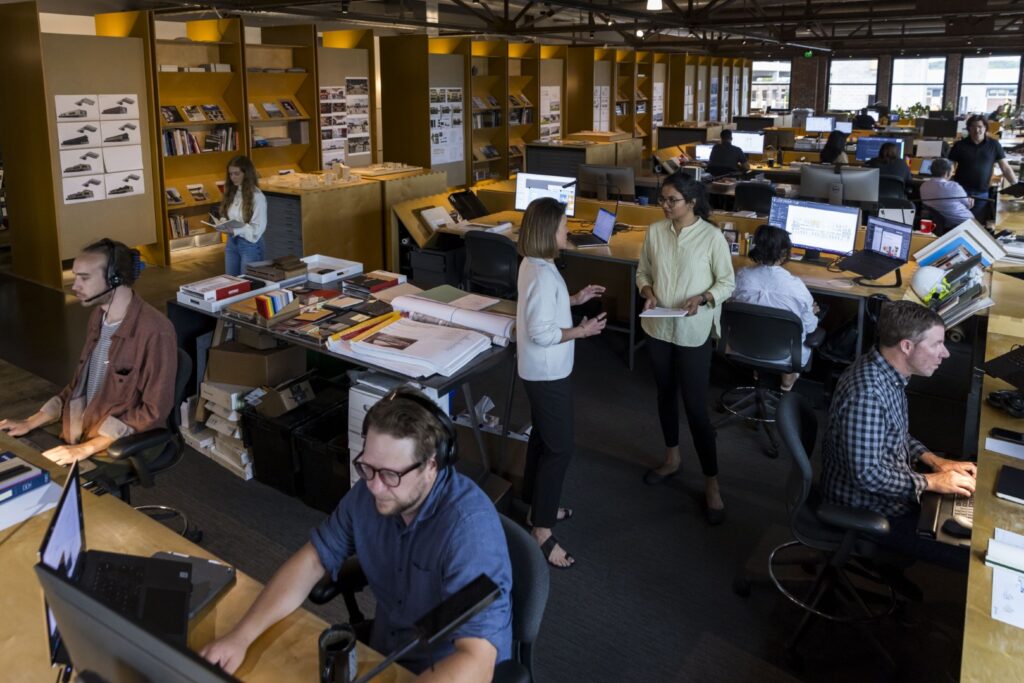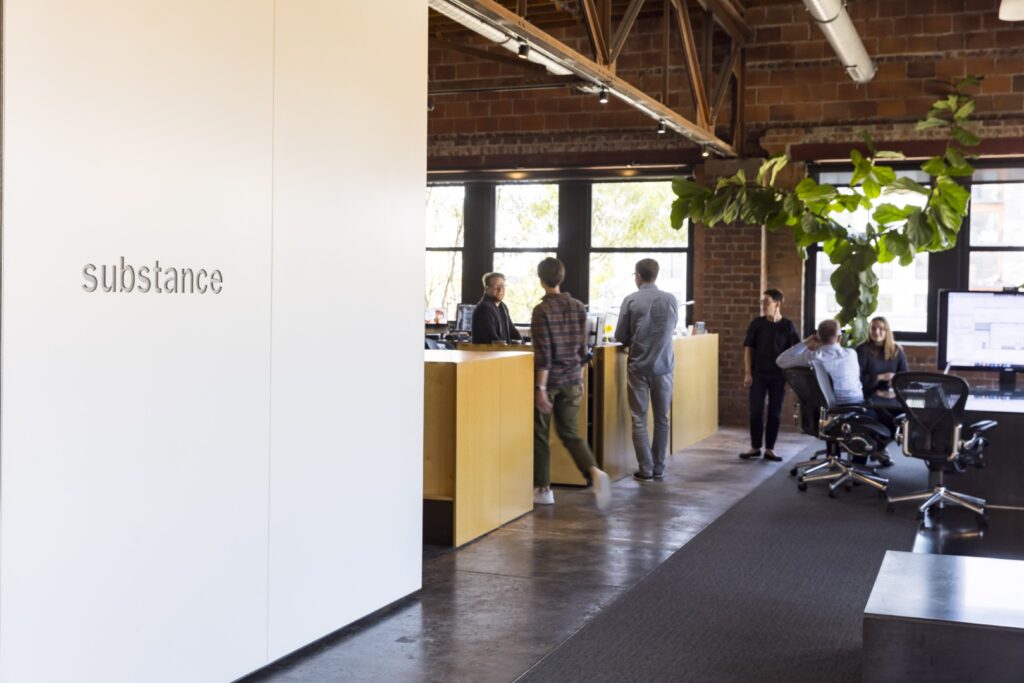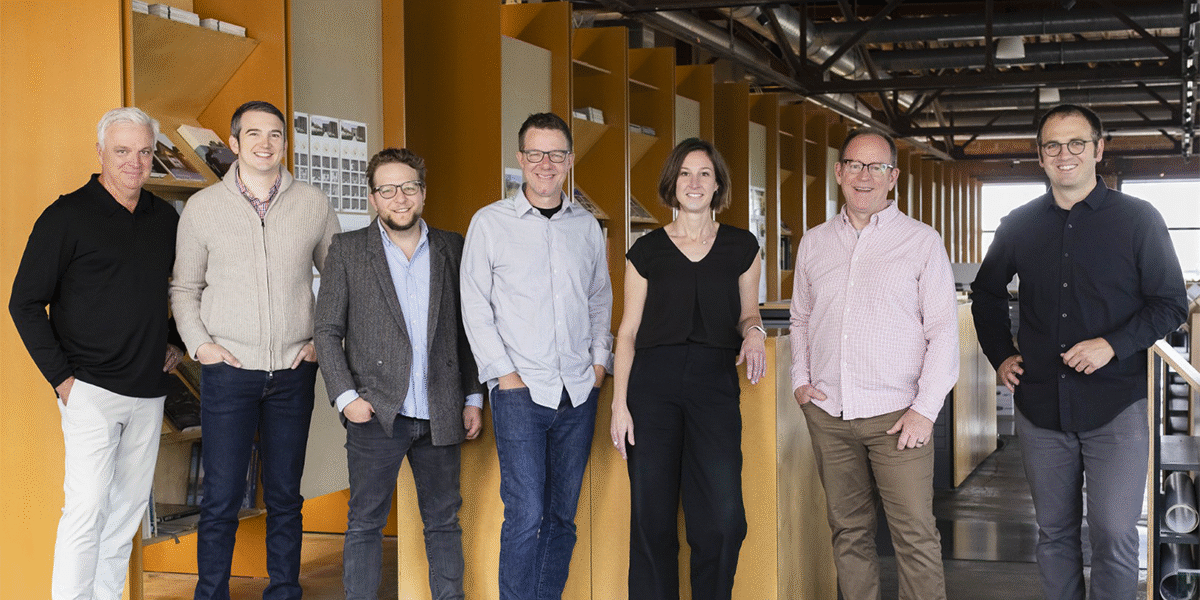Leah Rudolphi, AIA, is an Associate Principal at Substance Architecture in Des Moines, Iowa, who served as jury co-chair for the 2025 AIA South Dakota Design Awards. Earlier this morning, she presented a Juror Keynote with fellow co-chair and Substance Architecture Associate Principal Joshua Hemberger, AIA, LEED AP, as part of the 2025 AIA SD Annual Convention in Sioux Falls. Click here to read in-depth Q&As with Josh and Leah.
In this blog post, Leah shares a bit of background on the firm evolution that she and Joshua are helping colleagues navigate as they move into the owner role together. In the feature photo above, Leah appears at the center of the firm’s leadership group, with Joshua at far right.
Passing the Torch: Reflections on Our Firm’s Ownership Transition
I’m not an expert on ownership transitions—but I’ve recently been through one. Over the past few years, my colleagues and I at Substance Architecture, based in Des Moines, Iowa, began a deliberate and ongoing process to transition ownership from the original Partners to a new generation of leaders. This is a reflection on that journey—what we learned, how we approached it, and what others might take away from our experience.
A Turning Point
Substance was founded in 2005. Today, we’re a team of 19: three principals, four associate principals, three associates, seven design professionals, and two support staff. Like many architecture firms, the original Partners were close in age and had shared professional histories. Although the question of succession was always somewhere in the background, it never felt urgent—until it suddenly was.
In early 2022, one of the three original Partners announced an unexpected retirement. That moment forced the remaining partners to confront a reality that had seemed years away. The time to figure out the firm’s future wasn’t “someday”—it was now.

Choosing a Path
There are many ways to approach succession. A firm can be sold, closed, or handed off in any number of configurations. The remaining partners at Substance made a clear choice: they wanted the firm to outlive them. They were committed to preserving the culture, the values, and the relationships that had been carefully built over nearly two decades.
With this commitment came responsibility—not only to themselves, but to the team that had helped grow the firm. They needed a plan and the right people to carry it forward.
Building the Team
We hired a strategic planning consultant to guide us through the early phases of this journey. Through months of discussion and analysis, nine individuals were identified as candidates for future ownership, nearly all of them longtime members of the team, deeply invested in the success of the firm.
From this group, we ultimately selected one new Partner and four Associate Partners. Others joined the ranks of Associates, setting the stage for a broader, multi-generational leadership structure.
Crafting the Plan
To handle the complexities of the ownership transition, we brought in a consultant specializing in architectural and engineering firms. Working together, we designed a phased buy-in model tailored to our unique structure and the realities of our profession.
We knew that few architects have the cash to buy significant ownership stakes outright, and we didn’t want anyone taking on crippling debt. Instead, we built a system where new owners could buy shares incrementally, using a portion of the profits generated by those shares to fund the purchase over time. This approach kept the process financially sustainable for both buyers and sellers and allowed the firm to retain stability during the transition.
Navigating Legal and Financial Hurdles
Legal and financial guidance proved essential at every turn. Each founding partner retained individual legal counsel, and so did each new owner. Substance itself had a firm-wide legal advisor to manage the broader transition. Drafting a new operating agreement—from scratch—was one of the most time-consuming and difficult steps. The previous version was simple, reflecting equal ownership among three founders. The new one had to accommodate multiple owners, shifting shares, and evolving roles. After six months of bi-weekly meetings, we reached a consensus.
Accountants also played a vital role. As new owners, we moved from salaried employees to corporate shareholders drawing profit-based compensation. That meant learning how to manage taxes, cash flow, and financial planning in entirely new ways.

Facing the Emotional Side
Ownership is as much about mindset as it is about money. Becoming an owner comes with pride—but also fear and doubt. We asked ourselves hard questions: Can we continue to grow? What happens in a downturn? Are these the people I trust to build a business with?
There were also moments of loss. Of the nine people initially identified for ownership, four left during the process. Each departure was difficult, but ultimately, not everyone wants the responsibilities that ownership entails.
A New Chapter
Eventually, we finalized the paperwork, signed the documents, and celebrated the announcement with our clients, consultants, and broader community. We launched a redesigned website that marked the beginning of a new chapter for Substance Architecture.
Now, we’re still learning how to function as a broader leadership group. We’re refining roles, developing shared values, and mentoring a new layer of emerging leaders. As the founding partners gradually step back, we’re continuing to grow the next generation, adding new associates and rebalancing leadership duties.
Looking Forward
To young architects: ownership is possible. It takes time, commitment, and trust—but with the right support and mindset, you can get there.
To firm owners: the process is never easy, but starting early makes all the difference. Identify your successors. Commit to the long game. Build a structure that allows your firm—and its people—to thrive beyond your own career.
Your legacy doesn’t have to end when you step away. With care and planning, it can be just the beginning of something new.







